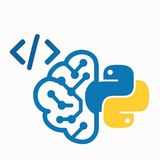This media is not supported in your browser
VIEW IN TELEGRAM
Aider got the top score on SWE Bench, a challenging benchmark in which Aider solved real-world problems on #GitHub from popular open source projects like #django, #scikitlearn, #matplotlib, etc.
🟡 Docs
Please open Telegram to view this post
VIEW IN TELEGRAM
Please open Telegram to view this post
VIEW IN TELEGRAM
Please open Telegram to view this post
VIEW IN TELEGRAM
👍10👾5🆒1
@CodeProgrammer Matplotlib.pdf
4.3 MB
The Complete Visual Guide for Data Enthusiasts
Matplotlib is a powerful Python library for data visualization, essential not only for acing job interviews but also for building a solid foundation in analytical thinking and data storytelling.
This step-by-step tutorial guide walks learners through everything from the basics to advanced techniques in Matplotlib. It also includes a curated collection of the most frequently asked Matplotlib-related interview questions, making it an ideal resource for both beginners and experienced professionals.
#Matplotlib #DataVisualization #Python #DataScience #InterviewPrep #Analytics #TechCareer #LearnToCode
https://t.me/addlist/0f6vfFbEMdAwODBk
Please open Telegram to view this post
VIEW IN TELEGRAM
👍12❤2💯1
NUMPY FOR DS.pdf
4.5 MB
Let's start at the top...
NumPy contains a broad array of functionality for fast numerical & mathematical operations in Python
The core data-structure within #NumPy is an ndArray (or n-dimensional array)
Behind the scenes - much of the NumPy functionality is written in the programming language C
NumPy functionality is used in other popular #Python packages including #Pandas, #Matplotlib, & #scikitlearn!
✉️ Our Telegram channels: https://t.me/addlist/0f6vfFbEMdAwODBk
NumPy contains a broad array of functionality for fast numerical & mathematical operations in Python
The core data-structure within #NumPy is an ndArray (or n-dimensional array)
Behind the scenes - much of the NumPy functionality is written in the programming language C
NumPy functionality is used in other popular #Python packages including #Pandas, #Matplotlib, & #scikitlearn!
Please open Telegram to view this post
VIEW IN TELEGRAM
❤19
import numpy as np
arr = np.array([1, 2, 3, 4, 5])
print(np.std(arr))
1.4142135623730951
#74.
np.sum()Sums array elements over a given axis.
import numpy as np
arr = np.array([[1, 2], [3, 4]])
print(np.sum(arr))
10
#75.
np.min()Returns the minimum of an array or minimum along an axis.
import numpy as np
arr = np.array([5, 2, 8, 1])
print(np.min(arr))
1
#76.
np.max()Returns the maximum of an array or maximum along an axis.
import numpy as np
arr = np.array([5, 2, 8, 1])
print(np.max(arr))
8
#77.
np.sqrt()Returns the non-negative square-root of an array, element-wise.
import numpy as np
arr = np.array([4, 9, 16])
print(np.sqrt(arr))
[2. 3. 4.]
#78.
np.log()Calculates the natural logarithm, element-wise.
import numpy as np
arr = np.array([1, np.e, np.e**2])
print(np.log(arr))
[0. 1. 2.]
#79.
np.dot()Calculates the dot product of two arrays.
import numpy as np
a = np.array([1, 2])
b = np.array([3, 4])
print(np.dot(a, b))
11
#80.
np.where()Returns elements chosen from x or y depending on a condition.
import numpy as np
arr = np.array([10, 5, 20, 15])
print(np.where(arr > 12, 'High', 'Low'))
['Low' 'Low' 'High' 'High']
---
#DataAnalysis #Matplotlib #Seaborn #Visualization
Part 8: Matplotlib & Seaborn - Data Visualization
#81.
plt.plot()Plots y versus x as lines and/or markers.
import matplotlib.pyplot as plt
plt.plot([1, 2, 3, 4], [1, 4, 9, 16])
# In a real script, you would call plt.show()
print("Output: A figure window opens displaying a line plot.")
Output: A figure window opens displaying a line plot.
#82.
plt.scatter()A scatter plot of y vs. x with varying marker size and/or color.
import matplotlib.pyplot as plt
plt.scatter([1, 2, 3, 4], [1, 4, 9, 16])
print("Output: A figure window opens displaying a scatter plot.")
Output: A figure window opens displaying a scatter plot.
#83.
plt.hist()Computes and draws the histogram of x.
import matplotlib.pyplot as plt
import numpy as np
data = np.random.randn(1000)
plt.hist(data, bins=30)
print("Output: A figure window opens displaying a histogram.")
Output: A figure window opens displaying a histogram.
#84.
plt.bar()Makes a bar plot.
import matplotlib.pyplot as plt
plt.bar(['A', 'B', 'C'], [10, 15, 7])
print("Output: A figure window opens displaying a bar chart.")
Output: A figure window opens displaying a bar chart.
#85.
plt.boxplot()Makes a box and whisker plot.
import matplotlib.pyplot as plt
import numpy as np
data = [np.random.normal(0, std, 100) for std in range(1, 4)]
plt.boxplot(data)
print("Output: A figure window opens displaying a box plot.")
Output: A figure window opens displaying a box plot.
#86.
sns.heatmap()Plots rectangular data as a color-encoded matrix.
import seaborn as sns
import numpy as np
data = np.random.rand(10, 12)
sns.heatmap(data)
print("Output: A figure window opens displaying a heatmap.")
Output: A figure window opens displaying a heatmap.
#87.
sns.pairplot()Plots pairwise relationships in a dataset.
❤2
